+Search query
-Structure paper
| Title | Structure of a bimodular botulinum neurotoxin complex provides insights into its oral toxicity. |
|---|---|
| Journal, issue, pages | PLoS Pathog, Vol. 9, Issue 10, Page e1003690, Year 2013 |
| Publish date | Oct 10, 2013 |
 Authors Authors | Kwangkook Lee / Shenyan Gu / Lei Jin / Thi Tuc Nghi Le / Luisa W Cheng / Jasmin Strotmeier / Anna Magdalena Kruel / Guorui Yao / Kay Perry / Andreas Rummel / Rongsheng Jin /  |
| PubMed Abstract | Botulinum neurotoxins (BoNTs) are produced by Clostridium botulinum and cause the fatal disease botulism, a flaccid paralysis of the muscle. BoNTs are released together with several auxiliary ...Botulinum neurotoxins (BoNTs) are produced by Clostridium botulinum and cause the fatal disease botulism, a flaccid paralysis of the muscle. BoNTs are released together with several auxiliary proteins as progenitor toxin complexes (PTCs) to become highly potent oral poisons. Here, we report the structure of a ∼760 kDa 14-subunit large PTC of serotype A (L-PTC/A) and reveal insight into its absorption mechanism. Using a combination of X-ray crystallography, electron microscopy, and functional studies, we found that L-PTC/A consists of two structurally and functionally independent sub-complexes. A hetero-dimeric 290 kDa complex protects BoNT, while a hetero-dodecameric 470 kDa complex facilitates its absorption in the harsh environment of the gastrointestinal tract. BoNT absorption is mediated by nine glycan-binding sites on the dodecameric sub-complex that forms multivalent interactions with carbohydrate receptors on intestinal epithelial cells. We identified monosaccharides that blocked oral BoNT intoxication in mice, which suggests a new strategy for the development of preventive countermeasures for BoNTs based on carbohydrate receptor mimicry. |
 External links External links |  PLoS Pathog / PLoS Pathog /  PubMed:24130488 / PubMed:24130488 /  PubMed Central PubMed Central |
| Methods | EM (single particle) / X-ray diffraction |
| Resolution | 2.055 - 30.0 Å |
| Structure data |  EMDB-2416:  EMDB-2417:  PDB-4lo0: 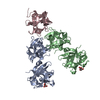 PDB-4lo1: 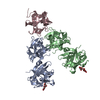 PDB-4lo2: 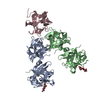 PDB-4lo3:  PDB-4lo4: 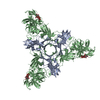 PDB-4lo5: 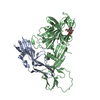 PDB-4lo6: 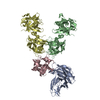 PDB-4lo7: 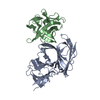 PDB-4lo8: |
| Chemicals |  ChemComp-HOH: 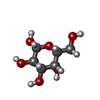 ChemComp-GAL:  ChemComp-CL: |
| Source |
|
 Keywords Keywords | PROTEIN TRANSPORT / progenitor toxin complex / botulinum neurotoxin / botulism / neurotoxin associated protein / hemagglutinin / carbohydrate/sugar binding / secreted protein |
 Movie
Movie Controller
Controller Structure viewers
Structure viewers About Yorodumi Papers
About Yorodumi Papers




